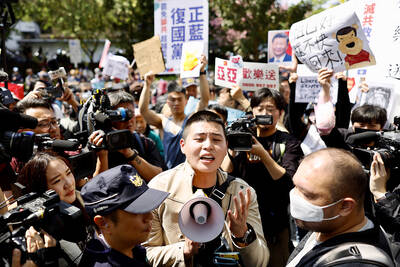The Diaoyutai Islands (釣魚台) are a territory of the Republic of China (ROC) “surreptitiously occupied” by Japan, the Ministry of Foreign Affairs said in a statement late on Friday night.
In the statement, issued in response to the release of 14 pro-China activists who were arrested by Japanese coast guard officers on Wednesday after they landed on the islands to assert Chinese sovereignty, the ministry used the phrase “surreptitiously occupied” to describe the Diaoyutais.
“Regarding the appearance of the ROC flag [in the protest staged by the pro-China activists] on the Diaoyutai Islands of our territory surreptitiously occupied by Japan, we thought it conformed to our government’s territory contention,” it said.
Asked to elaborate yesterday, MOFA spokesperson Steve Hsia (夏季昌) said it could be the first time that the ministry explained the origins of the disputes with Japan over sovereignty over the Diaoyutais in such a “straightforward” way.
“It was a factual description of history,” Hsia said.
According to Hsia, the Japanese government had planned to place national boundary markers on the Diaoyutai Islands as early as 1885, and on Jan. 14, 1895, it approved a policy that allowed Okinawa Prefecture to erect national markers.
Hsia said that the Japanese government had postponed taking action since 1885 because it knew that the Diaoyutai Islands had been discovered, named and used by the Chinese, as shown by various Japanese documents obtained by historians, including Shaw Han-yi (邵漢儀), son of retired government official Shaw Yu-ming (邵玉銘).
Japan erected its boundary marker on the Diaoyutai Islands in 1968, he said.
During the first Sino-Japanese War of 1894-1895, in January 1895, Japan annexed the Diaoyutais, the ministry said.
In April 1895, Japan and China signed the Treaty of Shimonoseki, which stipulated that China cedes the island of Taiwan to Japan, “together with all the islands appertaining or belonging to the said Island of Formosa [Taiwan],” it said.
In 1970, the US and Japan signed the Okinawa Reversion Treaty, which included the Diaoyutai Islands as part of Okinawa to be returned to Japanese rule.
Japan’s sovereignty claim over the territory was partly backed by the treaty, but the ministry disagreed.
“The treaty gives only administrative jurisdiction of the Diaoyutai Islands to Japan and has nothing to do with sovereignty,” Hsia said.
Since the 1970s, the Japanese government has claimed that “from 1885 on, surveys of the Senkaku Islands [the Japanese term for the Diaoyutais] have been repeatedly made by the Government of Japan through the agencies of Okinawa Prefecture,” Hsia said.
The Japanese government claimed that the islands had been uninhabited and showed no trace of having been under the control of the Qing Dynasty, the ministry said.
“The statement is historically inaccurate and can be refuted based on official Meiji documents from 1885 to 1895 stored in the various national archives of Japan,” it said.

ENDEAVOR MANTA: The ship is programmed to automatically return to its designated home port and would self-destruct if seized by another party The Endeavor Manta, Taiwan’s first military-specification uncrewed surface vehicle (USV) tailor-made to operate in the Taiwan Strait in a bid to bolster the nation’s asymmetric combat capabilities made its first appearance at Kaohsiung’s Singda Harbor yesterday. Taking inspiration from Ukraine’s navy, which is using USVs to force Russia’s Black Sea fleet to take shelter within its own ports, CSBC Taiwan (台灣國際造船) established a research and development unit on USVs last year, CSBC chairman Huang Cheng-hung (黃正弘) said. With the exception of the satellite guidance system and the outboard motors — which were purchased from foreign companies that were not affiliated with Chinese-funded

PERMIT REVOKED: The influencer at a news conference said the National Immigration Agency was infringing on human rights and persecuting Chinese spouses Chinese influencer “Yaya in Taiwan” (亞亞在台灣) yesterday evening voluntarily left Taiwan, despite saying yesterday morning that she had “no intention” of leaving after her residence permit was revoked over her comments on Taiwan being “unified” with China by military force. The Ministry of the Interior yesterday had said that it could forcibly deport the influencer at midnight, but was considering taking a more flexible approach and beginning procedures this morning. The influencer, whose given name is Liu Zhenya (劉振亞), departed on a 8:45pm flight from Taipei International Airport (Songshan airport) to Fuzhou, China. Liu held a news conference at the airport at 7pm,

AIR SUPPORT: The Ministry of National Defense thanked the US for the delivery, adding that it was an indicator of the White House’s commitment to the Taiwan Relations Act Deputy Minister of National Defense Po Horng-huei (柏鴻輝) and Representative to the US Alexander Yui on Friday attended a delivery ceremony for the first of Taiwan’s long-awaited 66 F-16C/D Block 70 jets at a Lockheed Martin Corp factory in Greenville, South Carolina. “We are so proud to be the global home of the F-16 and to support Taiwan’s air defense capabilities,” US Representative William Timmons wrote on X, alongside a photograph of Taiwanese and US officials at the event. The F-16C/D Block 70 jets Taiwan ordered have the same capabilities as aircraft that had been upgraded to F-16Vs. The batch of Lockheed Martin

GRIDLOCK: The National Fire Agency’s Special Search and Rescue team is on standby to travel to the countries to help out with the rescue effort A powerful earthquake rocked Myanmar and neighboring Thailand yesterday, killing at least three people in Bangkok and burying dozens when a high-rise building under construction collapsed. Footage shared on social media from Myanmar’s second-largest city showed widespread destruction, raising fears that many were trapped under the rubble or killed. The magnitude 7.7 earthquake, with an epicenter near Mandalay in Myanmar, struck at midday and was followed by a strong magnitude 6.4 aftershock. The extent of death, injury and destruction — especially in Myanmar, which is embroiled in a civil war and where information is tightly controlled at the best of times —